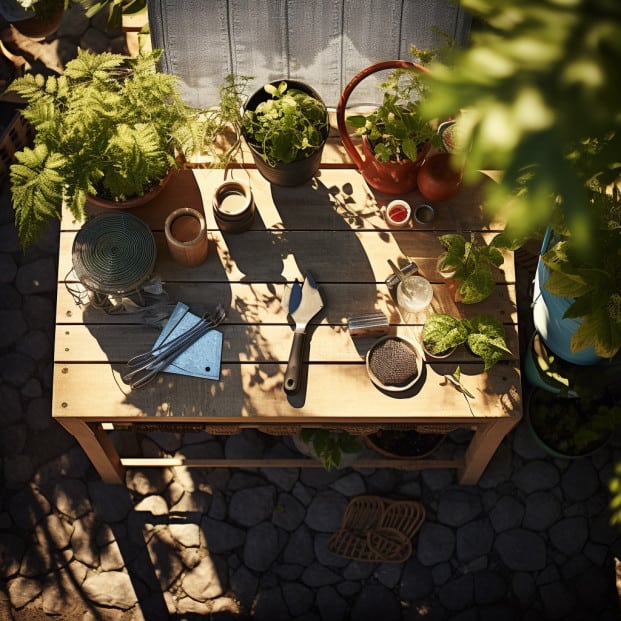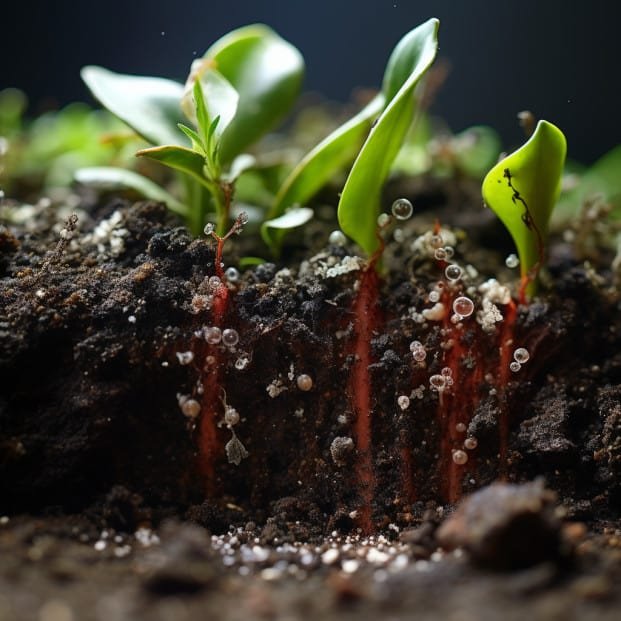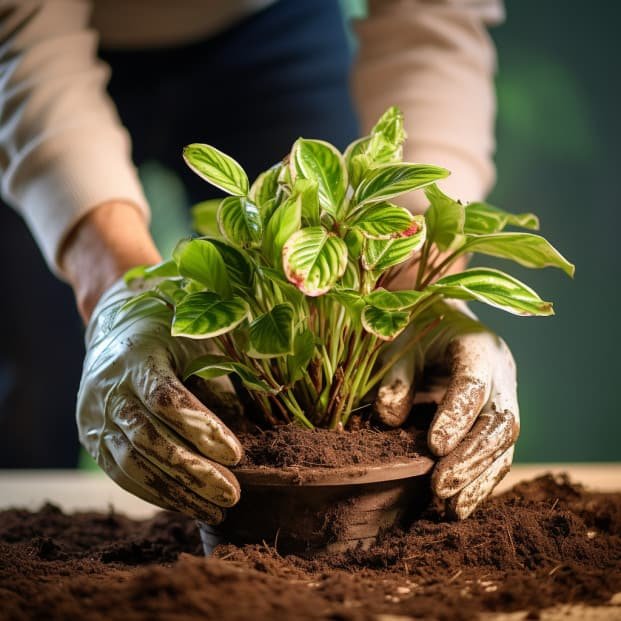According to The Spruce (1), mold on houseplant soil is usually harmless and can be fixed easily by improving drainage with soil amendments like perlite and sand, and ensuring the plant’s container has drainage holes that allow excess water to escape the pot.
Keep reading to learn more about how to prevent mold growth and what to do if you spot it.
KEY TAKEAWAY
How to get rid of mold from houseplant soil?
To banish mold from houseplant soil, prioritize proper drainage, adjust watering habits, and use effective treatments like repotting and natural anti-fungals.
Consistent care ensures a mold-free, thriving environment for your beloved green companions.
Unveiling the Mold Mystery: Why Does Your Houseplant Soil Get Moldy?
Mold growing in the soil of your favorite houseplant can be frustrating and concerning.
However, there are some common reasons why you may find mold in indoor plant soil.
Overwatering Promotes Mold Growth
Too much moisture is one of the biggest culprits for mold development.
Overwatering reduces air circulation and creates the ideal damp environment for mold spores to thrive.
Allow the soil to partially dry out between waterings.
Poor Drainage Traps Moisture
If water pools in the saucer or takes too long to drain from the pot, it leaves moisture behind. Use containers with drainage holes and well-draining potting soil.
Contaminated Potting Mix
Poor quality, old or reused potting soil that contains decaying matter can introduce mold spores. Start fresh with sterile commercial potting mixes.
Understanding the root causes of mold will help you make adjustments and prevent recurring mold issues in your houseplant soil.
Detecting Mold in Your Houseplant Soil: Signs and Symptoms

Noticing mold early allows you to take quick action before it spreads through the soil. Here are some telltale signs of mold in your indoor plant’s pot.
White Fuzzy Growth
The most obvious indicator is white fuzziness on the surface of the soil. This cottony mycelium produces spores that spread easily. (2)
Musty Smell
An earthy yet unpleasant musty or rotten odor coming from the plant likely means mold is present.
Poor Plant Health
If the leaves are spotty, yellow or dropping, contaminated soil could be the culprit. Mold competes with roots for oxygen.
Visible Mold Spores
Sometimes you may spot gray, black or green mold dots on top of the soil or pot rim. This points to active mold.
By regularly checking soil and being aware of symptoms, you can remove or replace moldy mix before it harms plant roots. Quick action preserves a healthy medium for your houseplants.
The Silent Culprits: Overwatering and Mold – Breaking the Connection
Overwatering is one of the main reasons mold thrives in houseplant soil. Too much moisture provides ideal conditions for mold growth. Here’s how to adjust watering habits to prevent mold.
Water Less Frequently
Allow the top inch or two of soil to dry out between waterings. This deprives mold spores of the constant dampness they need.
Watch for Wilting
Don’t wait until leaves are severely drooping to water. But some mild wilting signals the plant needs a drink versus keeping the soil soggy.
Feel the Soil
Get in the habit of checking soil moisture with your finger before watering. Only add water when soil is partly dry.
Loosen Compacted Soil
Dense, compressed soil prevents excess moisture from draining properly. Regularly cultivate with a fork to increase air circulation.
Overwatering and mold go hand in hand. Tweaking your schedule and methods to water less often breaks the cycle for mold-free houseplant soil.
Drainage Dilemma: How Poor Soil Drainage Invites Mold

Excess moisture trapped in soil due to poor drainage gives mold an open invitation. Here are some tips to improve drainage and safeguard against mold.
Use Containers with Holes
Plant in pots with adequate holes in the bottom to allow water to easily flow out. Holes also promote air circulation.
Opt for Fast-Draining Mix
Avoid dense, water-retentive soil that takes forever to dry out. Choose loose, sandy commercial mixes made for containers.
Add Ingredients Like Perlite
Mix in porous amendments like perlite, pumice or bark chips to prevent soil from compacting and enhance drainage.
Discard Water in Saucers
Don’t allow plants to sit in water-filled saucers, which keeps soil soggy. Empty excess water after watering.
With a few simple fixes, you can transform slow-draining soil into a lighter, airier medium that dries out between waterings to prevent mold growth.
Fungus Fighters: Effective Ways to Get Rid of Moldy Soil
If you spot mold in your houseplant’s soil, take action to get rid of it and prevent its return. Here are some effective methods:
Repot in Fresh Sterile Soil
Discard moldy soil and gently wash the roots. Repot the plant in a clean container using fresh sterile potting mix.
Treat with Baking Soda
Sprinkle 1 teaspoon baking soda per 6 inches of soil. The antifungal properties help eliminate mold. Repeat weekly.
Apply Hydrogen Peroxide
Mix 1 part 3% hydrogen peroxide with 4 parts water. Gently pour over the soil to kill mold on contact.
Increase Air Circulation
Improve airflow around plants by rotating pots or using small fans. This inhibits mold growth.
Catching mold early and taking swift action minimizes harm to plants. With consistent prevention methods, your houseplant soil can stay mold-free.
Let There Be Light: Using Sunlight to Banish Mold

Sunlight is nature’s disinfectant and an effective mold inhibitor. Try these clever tips to leverage sunlight against mold in houseplant soil:
Rotate Pots
Periodically turn pots to expose all sides to direct sunlight, which kills mold spores. Just avoid hot afternoon sun.
Uncover the Soil
Gently remove any top dressing like moss so the soil surface gets light. Replace coverings weekly.
Use a Sunny Window
Place plants on a windowsill that receives 4+ hours of sunlight daily. UV rays inhibit mold growth.
Supplement with a Grow Light
If natural light is inadequate, use an LED grow light to shine on the soil for part of the day.
Sunshine on a regular basis keeps soil mold-free without harming your houseplant. Use it strategically to create an unfavorable environment for mold.
Air Allies: Enhancing Circulation for Mold-Free Houseplants
Good airflow is critical to preventing mold in indoor plant soil. Stagnant air allows mold spores to thrive. Promote airflow with these tips:
- Position plants away from crowded areas and walls. Allow space between pots for air movement.
- Use oscillating or small desk fans to keep air circulating around plants.
- Occasionally rotate pots to expose all sides to fresh air.
- Choose loose, chunky potting mixes that allow air to permeate the soil.
- Prune dense growth that blocks air from reaching the soil.
Improving circulation dries out soil between waterings, creating an unfavorable environment for mold. Keep air moving for healthy houseplants.
Future-Proofing Your Green Companions: Preventing Moldy Soil with Smart Practices
An ounce of prevention is worth a pound of cure when it comes to mold in houseplant soil. Here are some savvy ways to reduce mold risk:
- Allow soil to dry out partially between waterings. Only water when the top few inches are dry.
- Check that containers have adequate drainage holes. Use well-draining soil mixes.
- Apply hydrogen peroxide or Bacillus subtilis regularly to suppress and prevent mold.
- Prune leaves and stems to improve air circulation to the soil.
- Repot annually in fresh sterile soil to eliminate any lingering mold spores.
- Give plants ample sunlight. UV rays inhibit mold growth.
With vigilance and preventative care, you can keep your houseplant soil free of pesky mold for the long term.
Healthy soil equals healthy plants!
Frequently Asked Questions
What types of mold commonly affect houseplant soil?
The most common types of mold that affect houseplant soil are white mold and black mold.
White mold, also known as saprophytic fungus, appears as a white fuzzy growth on the top layer of soil or dead leaves.
Black mold tends to grow in areas with high humidity and poor air circulation.
How can I tell if my houseplant soil has mold?
Some common signs that your houseplant’s soil may have mold include noticing a white fuzzy or gray/black growth on the top layer of soil, leaves, or dead organic matter like dead leaves.
You may also see other symptoms like poor plant health, root rot, or loss of leaves if the mold is severe and left untreated.
What causes mold to grow in houseplant soil?
Several factors can contribute to mold growth in houseplant soil.
High levels of organic matter, overwatering, poor air circulation, and high humidity are some of the main causes.
Leaving dead leaves and debris in the soil can also encourage mold by providing extra organic material for mold to feed on.
How do I safely remove mold from houseplant soil?
To safely remove mold, gently remove the top layer of soil that has visible mold growth.
You can sift out other organic debris while you do this.
Then add fresh sterile soil to the top layer.
Be sure not to overwater and allow the new soil to dry out between waterings.
Increasing air circulation and exposure to indirect sunlight can also help prevent mold regrowth.
What is the best way to prevent future mold growth?
Some tips for preventing future mold growth include improving drainage and air circulation, monitoring watering schedules, removing dead or decaying material, and allowing the top layer of soil to partially dry out between waterings.
You can also consider repotting plants in sterile potting mix if mold recurs.
Maintaining good air circulation and exposure to indirect sunlight also discourages mold growth.
Conclusion
Mold in houseplant soil is common but can be prevented.
The keys are moderating water, improving drainage, and enhancing air circulation.
Allow the soil to partly dry out before watering again.
Repot plants in containers with drainage holes using lightweight, sterile mixes.
Turn pots routinely so all sides get sun and air.
Natural antifungals like hydrogen peroxide also help eliminate mold.
With vigilance to reduce moisture and increase airflow, you can break the mold cycle for good.
What tips have worked to banish mold from your indoor plant soil?
Share your mold-fighting wisdom in the comments!
References
- https://www.thespruce.com/mold-on-houseplant-soil-5496610
- https://www.aerifyplants.com/post/what-to-do-if-mold-is-growing-on-the-soil-of-your-plants#:~:text=The%20layer%20of%20mold%20on,causing%20a%20white%2C%20fluffy%20layer.
Related Articles
- https://allthingsgardener.com/can-indoor-plants-cause-mold-in-your-house/
- https://allthingsgardener.com/potting-soil-smells-bad/
- https://allthingsgardener.com/diatomaceous-earth-for-indoor-plants/


